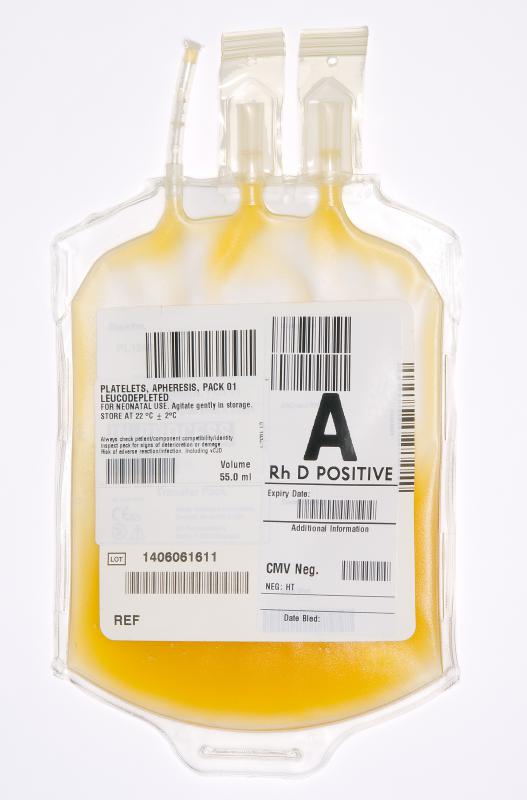At TheHealthBoard, we're committed to delivering accurate, trustworthy information. Our expert-authored content is rigorously fact-checked and sourced from credible authorities. Discover how we uphold the highest standards in providing you with reliable knowledge.
What is Plasmapheresis?
Plasmapheresis is a medical procedure in which blood is removed from the body and spun in a centrifuge to filter out the plasma. The red blood cells are returned to the body, and the plasma may be treated and reintroduced, or replaced, depending on the condition which the plasmapheresis is designed to treat. This technique is also used by blood banks for plasma donors, in which case the filtered plasma is tested to make sure that it is safe, and then packaged for use by hospitals.
In the popular American television series House, it seems like Dr. House is constantly ordering plasmapheresis for his patients. In fact, this treatment is relatively rarely used, especially in the United States, with most doctors using it specifically for the treatment of autoimmune conditions. Plasmapheresis is also not an effective therapy on its own, as it must be combined with more long-term treatments which are designed to address the issue causing problems with the blood plasma in the first place.

In a typical plasmapheresis session, a venous catheter is placed in the patient, and then hooked up to a plasmapheresis machine. As the blood is pulled out, it is treated with an anticlotting agent to keep it from clotting up outside the body. After being spun, the red blood cells are returned. In some cases, the plasma is treated and then returned, and in other instances it may be discarded and replaced with fresh plasma or a stand-in of some form. If the plasma is being collected for donation, it is pulled off into sterile packaging.

As a general rule, plasmapheresis is not painful, but it can be uncomfortable, depending on the type of plasmapheresis being used to treat the patient. Like any medical treatment, it also has potential side effects and complications, of which the most common is an infection at the site of the catheter. A doctor will generally discuss the reasons for recommending plasmapheresis treatment, along with the potential risks, when discussing treatment options with a patient.

People who wish to donate plasma during a blood drive should be prepared for a more lengthy sit than would be required to donate blood. However, the advantage of donating plasma is that your body recovers more quickly. Within 48 hours, the body should be returned to normal, and one could potentially donate again. Not all blood banks have the facilities to handle plasmapheresis at mobile blood drives, so it is a good idea to call ahead if you only want to donate plasma.
AS FEATURED ON:
AS FEATURED ON:















Discussion Comments
One of the interesting things about plasma donation is that they are usually after the complete opposite blood type from blood donation. I'm not sure why it works this way, but blood type O is considered the universal donor for whole blood, as it can be given to people of all blood types (although it's still better to match the blood types).
But, with plasma blood type AB is the universal donor. I guess it's got something to do with the way the cells work. Unfortunately, AB is one of the most rare blood types, so if you do have that type, you should consider being a plasma donator, rather than a whole blood donator if you can.
@croydon - Even though it takes longer, I find it tends to be a bit more personal. The nurses need to keep a better eye on you, I guess because the procedure takes longer and because you are more likely to react badly to blood cells being returned than to just having them taken out.
When I go to the clinic, they usually have a good TV show playing where everyone can see, or they offer us headphones for music if we want them.
And the nurses are all so nice, I often spend the whole time just talking to one of them.
And I've never had any plasmapheresis side effects either. At most I get a bit dizzy, but I suspect that is psychosomatic, because being stuck with a needle makes me a bit nervous.
The blood banks here were quite keen for people to try plasmapheresis, as there was more demand for plasma and it could be done every six weeks, rather than every three months like with blood donations.
I managed to do it once, but just have too many other commitments to do it regularly. I think it is a fantastic thing for people to do if they can work it into their schedule though.
Unfortunately, it takes much longer to donate plasma than to donate whole blood, I guess because it has to go through that machine in order for the red blood cells to be returned to you. It took about 45 minutes, I think, while when I give blood it only takes about 15 (not counting the sign in and wait for both activities). So you have to take that into account as well.
Post your comments